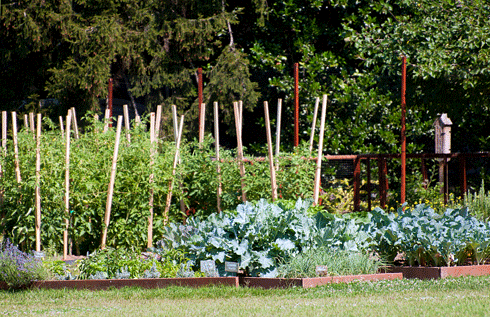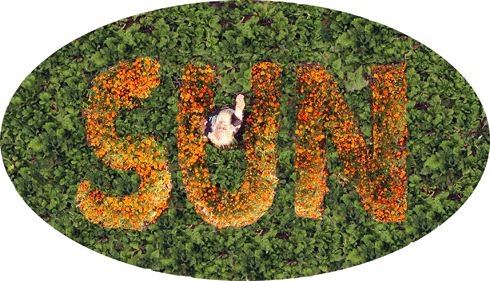
|
Published: 27 May 2013
Can urban farms feed city and soul?
Green walls, rooftop vegetable gardens and balcony growing systems are capturing the imagination of city-dwellers everywhere. But is it time for a reality check on the viability of producing food in urban environments?

|
|
Urban food gardens got a huge boost in the US in 2009, when America’s first lady, Michele Obama, set up this vegetable garden at the White House. Credit:
Pamela Joe McFarlane/istockphoto
|
Over the past few years Australia has seen intense interest in urban food growing. A dizzying array of new technologies – some complex, some simple – has emerged. Wall-mounted systems, ‘window’ gardening, aquaponics and rooftop food production with integrated water recycling are just a few.
Does our enthusiasm for new urban food production technologies match the reality? What goals should we have for urban agriculture? Should we chase the promise of high-yielding, high-value produce, or should our priority for city farming be integrated well-being: pursuing goals such as connectedness to the land and to each other?
Aquaponics at CERES
At the Centre for Education and Research in Environmental Strategies (CERES) in Melbourne’s inner north, a prototype aquaponic system has been set up to answer some of these questions.
Environmental engineer Stephen Mushin has worked with biologist and aquaponics expert Dr Wilson Lennard to design the system and accompanying research project. It’s now been running for more than a year.
‘Everyone’s excited about urban agriculture. It’s hugely fashionable to talk about it in design engineering circles and is something that the public is quite captivated by in general,’ says Mr Mushin.
‘But, there are a lot of question marks over whether it stacks up in terms of being a profitable thing to do in the city centre. It’s certainly possible to grow the food; but, would anyone buy the food at the price it costs to grow it on that small a scale?’
Mr Mushin and the CERES aquaponics team are investigating whether small-scale commercial aquaponics is commercially viable in an urban setting. The data being recorded include set up costs, production costs (e.g. labour), yield, price at market and time to market.
‘It’s very expensive to grow food in the city, because you’re working at a small scale,’ explains Mr Mushin. ‘And as we all know, economies of scale are very important.
‘So, what we’re trying to nut out is “Can we have small, little distributed commercial aquaponic systems that would operate on small, temporarily available pieces of land, schools and community spaces, and be easily run?”’
Chris Grose for Scoutfilms; music ‘See You Later’ by Pitx (featuring Fireproof Babies, Bmccosar)
The CERES also site hosts two organic market gardens that cover about one hectare. The produce is sold at local farmers markets, included in CERES’s veggie box scheme (CERES Fair Food), and sold at the CERES café after being turned into seasonal meals and products such as jams and preserves. The market gardens are also being compared to the aquaponic system as part of the aquaponics research project.
Mr Mushin says the other question they are asking is: ‘Is it a good idea to use aquaponics as a technology for small-scale urban food growing? Or, would you be better to use simple raised bed gardens or other more well-known and understood basic forms of farming?’.
While the CERES research project is still underway, Mr Mushin believes it is already generating some valuable insights about how the economics of our current food system influences the viability of urban farming.
‘We pay too little for food,’ he says. ‘Although people perceive the prices are going up, historically we are paying less, relative to income, than ever before. The reason we can do this is that by and large, as a society, we still don’t price externalities [e.g. water, power, the environmental costs of fossil-fuel intensive farming] at a rate that makes many sustainability initiatives cost competitive with their fossil fuel-intensive alternatives.’
‘So, if you took into account the fact that traditional farming is often fossil-fuel and water intensive – and if you properly price those emissions and essential environmental services – you’d find that urban agriculture produce is viable and stacks up. And, you’d have a farm around every street corner.’
Urban agriculture and ‘food literacy’
Nick Rose, National Coordinator of the Australian Food Sovereignty Alliance, is an independent academic and consultant who specialises in food justice issues. Like Mr Mushin, he believes that systemic issues are holding back the potential expansion of urban agriculture.
‘It’s a challenge not just across the food system, but the whole economy,’ says Dr Rose. ‘We need to internalise the costs of production: environmental costs (pollution) and social costs (obesity) are mostly externalised and passed on to general public via the health system or general taxation, or passed on to future generations. That’s not fair, it’s not resilient, and it’s not sustainable.’
According to Dr Rose, part of the problem is the profound disconnection from the basics of food production found among Australia’s largely urban population.
‘Most city dwellers relate to food through the price mechanism in the supermarket,’ he explains. ‘We don’t really think about what work went into growing that food and we just don’t know what’s involved. There is a real lack of knowledge among urban people about how food is grown, the market conditions for farmers, and what the impacts of certain forms of farming are on the land and water tables.’
Dr Rose is interested in urban agriculture partly as a means to address this disconnection. He talks of ‘food literacy’ – a concept that encompasses not only healthy eating and cooking skills, but also ‘a deeper understanding of where food comes from and the potential impacts of food production on the health of our environment.’
‘Urban agriculture offers a way to develop a more integrated understanding among city dwellers of what food means in terms of well-being and connectedness,’ he says.
Dr Rose is co-author of a 2013 report, Urban Food Security, Urban Resilience and Climate Change , funded by the federal government’s National Climate Change and Adaptation Research Facility (NCCARF).
As part of his research, he interviewed more than 50 people from different walks of life in and around Melbourne: from local government planners and health and nutrition professionals to commercial-scale market gardeners, food security advocates, and community and backyard gardeners.
Among the urban agriculture developments Dr Rose identifies in the report are the perceived opportunities for growing urban food on currently unused or underused land in Australia’s cities.
‘There are substantial parcels of idle, publicly owned land that may be suitable for urban food growing,’ he says. ‘Railway sidings are one example: another is land that is otherwise unsuitable for development because it is flood prone or subject to erosion.’
Rose and his colleagues at the Australian Food Sovereignty Alliance believe urban agriculture has a vital role to play in meeting Australia’s future food requirements, as well as key health and environmental goals.
‘The federal government is about to release this country’s first-ever National Food Plan. What a fantastic signal it would send to state and local governments, and the community in general, if the roll out of urban agriculture was included in the plan as a key policy priority.’
In the NCCARF report, Dr Rose and his co-authors identify some hotspots of urban food production and innovation in Australia, including Melbourne’s inner west and Southport on the Gold Coast. At Southport, the community group Permaculture Gold Coast runs a market garden on a vacant three-quarter acre suburban block with the cooperation of the developer owner.
In addition to selling compost and vegetables produced on site, the group has partnered with the Salvation Army to train long-term job seekers in permaculture and bio-intensive gardening practices.
Selecting urban space for food growing
Like Dr Rose, John McBain – a former biodynamic farmer and horticulturalist turned urban food growing guru – thinks a lot about urban space and food growing. Mr McBain, who is the Western Australian representative of the Australian City Farm and Community Gardens Network, is creating a model halfway between a market garden and a community garden.
‘It will operate more sustainably than a market garden, and more productively and commercially focused than a community garden,’ he says.
Mr McBain’s Sustainable Urban Nutrition (SUN) concept is the intensive local conversion of green waste into food through a network of gardens within walking distance of every house, thereby reducing food and waste miles.
His South Perth rental property has been a test bed for a range of low-technology food growing solutions, including vermigation (irrigation with worm-farm leachate) fed by a hot composting process.
The SUN project is now being established in a local sporting club, the City of South Perth’s Collier Park Golf Course, and Murdoch University’s Community Garden at the University’s Environmental Technology Centre.
Mr McBain believes that underused urban spaces are ideal for food production, but adds that it is also important to choose spaces are already well trafficked.
‘If you want something successful in terms of location, you have to have high numbers of people already going there,’ he says. ‘We want to integrate with other public uses of open space.’
‘Recently, I met with the Mayor of South Perth, and we walked across the main community hub in South Perth, which includes parkland, sporting clubs and the council offices. It’s a very highly trafficked area.’
Mr McBain points out that he could easily identify fringe open spaces in this hub that are not highly used.
‘Instead, I pointed out all the fencing to the Mayor. The bowling club has waist-high fencing and the council premises have fencing over six foot high. There are hundreds and hundreds of metres of fencing.
‘On my property, we’ve now started a small trial of climbing peas, spinach and broad beans to see what production we can get out of x metres of fencing if you garden vertically. We’re all about using waste; a fence that is just a fence is a waste in terms of urban food production.’




